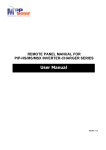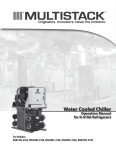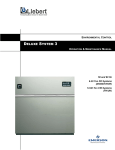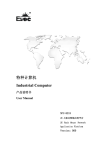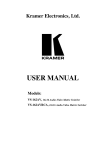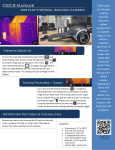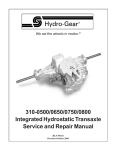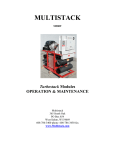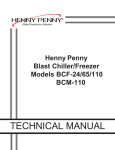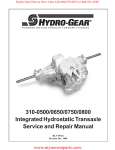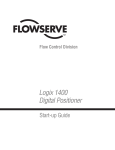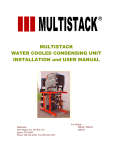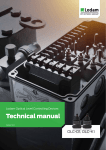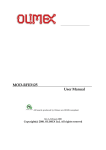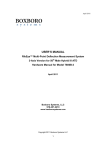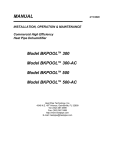Download Water-to-Water Heat Pump
Transcript
Water-to-Water Heat Pump Operation Manual Table of Contents 1.0 Chiller Identification 9.6 Expansion Valve 1.1 Water Cooled 9.7 Variable Flow 1.2 Serial Number 9.8 ISO Valve 2.0 Theory of Operation 9.9 HGBP 3.0 Water Treatment 9.10 Nameplate 4.0 Flow Protection 10 Factory Setup 5.0 System Water Volume 11 Daily Log 6.0 Condenser Water Temperature Control 12.0 Pressure Readings 7.0 Refrigerant Relief and Monitoring 13.0 Strainer Cleaning 8.0 Electrical Data 14.0 Refrigerant Charge 8.1 Single Module 15.0 Filter Driers 9.0 Components 16.0 Superheat / Subcooling 9.1 Master Control 17.0 Pressure Relief 9.2 Low Voltage 18.0 Annual Maintenance 9.3 High Voltage 19.0 Compressors 9.4 Compressors 20.0 Heat Exchangers 9.5 Water Connections 21.0 Troubleshooting 2 1.0 Chiller Identification The module data plate which contains the model and serial number for all MS modules is located on the “B” side electrical box door of each module. 1.1 Water Cooled Model Number Existing MS 50 X 1 H 1 W 0 R-410A New MS 050 X N 1 H 1 R 0 A A -410A Refrigerant Condenser6 Evaporator5 AHRI Version - if applicable Application4 Module Number (1 - single, 2 - multiple) Voltage3 Configuration2 AHRI Certified (C - certified, N - Not certified) Compressor Type1 Module Nominal Capacity (10 - 160 tons) Series B: Bristol, C: Trane Cornerstone, R: Bitzer Screw, S: Trane Scroll, T: Danfoss Turbocor, Z: Copeland scroll (old elec), X: Copeland Scroll (ZP), A: Copeland Scroll (ZR) 1- Standard, 2- Total access, 3 - Evap extended headers, 4 - Cond extended headers, 5 - Both extended headers, V - others 3 A - 208/3/60, L - 230/3/60, H - 460/3/60, C - 575/3/60, D - 200/3/50, E - 400/3/50, F - 380/3/60, S - 220/230/1/60, V - other 4 C - Single module temp controller, A-Air Cooled split, D - Cond unit, F - Fluid cooler (high temp),H - Heat recovery, R - Heat pump, W - Water cooled 5 A - Brazed SS, B - Brazed SMO, C- S&T copper, D - S&T cu-Ni, V - Other 6 A - Brazed SS, B - Brazed SMO, C- S&T copper, D - S&T cu-Ni, E - Double wall brazed, V - Other 1 2 2.0 Theory of Operation The Multistack Heat Pump provides chilled or heated water to an external load based off of the Load Return Water Temperature to the Multistack Master Control. When the Entering Load Water sensor sends the signal to the Master Control that heating or cooling is needed, compressors will begin to start producing heated or chilled water. The point at which the ELW temperature calls for compressors to start is determined by the Up Setpoint and the Variable Setpoint setting in the System Variables menu of the Master Control. When the ELW sensor senses that the heating or chilled water temperature has dropped below the Set-Point, compressors will begin to cycle off. On modules equipped with modulating butterfly valves on the Load side, each module’s valve will control off of the Leaving Load water Setpoint (Lo Setpoint in System Variables). The module slave board of each will send a 2-10VDC output to each valve actuator to modulate the water valve to maintain Lo Setpoint. Modules that are in the OFF Mode will have their valve closed so water will not mix with running modules. For Variable Flow applications you can select to keep 1 or more valves open at all times for minimum flow through the chiller. This is done in the Factory Setup Menu. The valve that stays open will always be the lead compressor for that day. This feature eliminates the need for an external bypass to be installed at the chiller. On the source side, if modulating butterfly valves are used on each module, the controller looks at the Source Water PSIG setpoint located in the Factory Setup Menu. This is also a 2-10VDC output each module board sends to the valve actuator. Since the controller waits 10 seconds after start of the 1st compressor to look for Source Water flow no minimum flow in the off mode is needed on the Source side if the condenser pump shuts off when the last module shuts off. If the Source Pump stays running you will need to set up the number of valves to be open for minimum flow in the Factory Setup. 3 3.0 Water Treatment Proper Water treatment is essential to ensure the peak efficiency and performance of the heat pump. The Source and Load water quality should be kept within the following parameters to prevent any damage to the heat exchangers. The use of hydrochloric, sulfuric, and muriatic acids as well as household bleach can cause stress corrosion to the stainless steel in the heat exchangers. Use of these or any other unapproved chemicals is not covered under the Multistack warranty. Chlorides are the most harmful chemical to the 316L stainless steel used in the heat exchangers. For installations in areas where chlorides are high please contact Multistack in regards to the optional molybdum steel heat exchanger. Multistack Water Guidelines PH >7-<9 TDS < 1000 ppm Hardness 30 - 500 ppm Alkalinity 30 - 500 ppm Chlorides < 200 ppm Sulphates < 200 ppm 4.0 Flow Protection Proof of flow on both the Load Water and Source Water side is required to be supplied to the Master Control inputs. Flow or DP switches may be used. Unless special ordered with the heat pump these switches should be field supplied and installed by the contractor. Heat Pumps purchased with optional Load or Source Water pump modules do have a DP sensor installed across the pump to insure the pump is running. Multistack still recommends a flow or PD switch be installed in the leaving water side for a flow switch and across the inlet and outlet water take-offs of the Load and Source side for a DP switch. 5.0 System Water Volume Chilled and Heated water systems work to remove the thermal gain from the process in which they are cooling or heating. In a properly sized load side water system, the heat pump will have enough time to properly control, respond to changes in load, and prevent short cycling of the heat pump. To ensure the system water volume is adequate, a general rule of thumb is: 7-10 gallons of water per ton or Acceptable Load Water Volume = Load Water Design GPM X 3 In the event the system components can’t hold the necessary load water volume, a properly sized load water storage tank should be added. 6.0 Source Water Temperature Control For installations where in the Cooling Mode leaving source water temperature can be lower than 75 degrees, Multistack recommends a means of source water temperature control be applied. A bypass valve that directs partial heated ground water directly back to the chiller without going to the ground loop until the leaving source water can be maintained at a minimum of 75 degrees is one option. 7.0 Pressure Relief Piping and Refrigerant Monitoring Because of the small amount of refrigerant charge in each module (.6 lbs per ton) most modules are exempt from ASHRAE 15 Standard. Unless required by local code and special ordered with the modules, pressure relief valves are not standard on MSX modules. 8.0 Electrical Data Field wiring should be done in accordance with all federal, state and local regulations. 1. Breakers, fuses, wire, and wire gauge must be sized and installed per the National Electric Code (NEC). 2. Applied voltage to all Multistack heat pumps must be ± 10% of the unit’s nameplate voltage. 3. The voltage imbalance between phases must not exceed 2%. According to NEMA Standard MG-1-1998, a 2% voltage imbalance will cause a current imbalance of 6 to 10 times the voltage imbalance. It is very important to keep the unbalance between electrical phases to a minimum. 4. All Multistack heat pumps come standard with a single point of connection up to 500 Amps. Above 500 Amps, the machine will have dual points of electrical connection. This feature simplifies the electrical install. 5. It is intended that the main electrical conduit feeding the Power Junction Box be fed from the top, bottom, or left side of the panel when looking at the panel. 6. Please note that there is a dedicated chiller ground in this panel. This ground must reference a true earth ground. 8.1 Optional Single Module Field Connection For installations using only 1 module, the Power Junction Box can be deleted. The main electrical feed can connect directly to the module’s circuit breaker. See the installation Manual for further information. 4 9.0 Components 9.1 Master Control Panel Each heat pump will have 1 Master Control Panel. The Master Control can be set on top of any of the modules. The top panels for the modules have knockouts available to run sensors, cables, and wiring into the bottom of the Master Control. If desired a hole can be drilled into the side of the Master Control to wire in flow sensors, interlock, and BAS wiring. The Master Control has the terminal strip inputs for flow switches, start/stop, alarm output, and phase monitor. When shipped, the Master Control Panel will contain the system sensors, and the P-Lan communication wire to be field installed by the start up technician. 9.2 Module Control Boards and Low Voltage Panel The module control boards communicate with the Master Control to send individual module temperature and pressures to the central control. Each Module has an AUTO/ OFF/ MANUAL switch. Normal operation would be in the AUTO mode. If there is a problem with the Master Control, the selector switch can be changed to MANUAL to control from the individual module leaving load water temperature which would be pre-set through the Master Control. 9.3 High Voltage Panel The high voltage panel contains each compressors contactors, disconnects, control relay’s and the module transformer. External to the panel is a single module disconnect that isolates the entire module from the high voltage supply. 9.4 Compressors, Sensors, Switches. 1. Standard modules use two scroll compressors, each with a separate refrigeration circuit. 2. Each compressor has an HP and LP transducer that sends pressures to the module slave board as well as an HP switch with a manual reset button. 3. Transducers are a 0-5V ratiometric type. 4. Compressors have oil level sight glasses. Oil level should be at ¼ - 1/8 full during operation. 5. Each circuit will have its own Leaving Load Water Sensor as well as Refrigerant Suction Temperature Sensors. 6. The Master Module has and Entering Load Water Sensor. 7. Compressor crankcase heaters are not used as standard on MSX modules. 9.5 Load and Source Side Water Connections. 1. Water connections to the load and source side are standard 6” grooved fittings. The upper header on the Load Water side is Entering Water to the module. Bottom header is Leaving Load Water from the module. The source side is the same. 2. Entering to the module is on the top while leaving water is on the bottom. The Entering header on both sides contains a 30 mesh filter strainer to prevent debris from entering the brazed plate heat exchangers. This filter should be used as a last means of defense. 3. Proper filtration before the module should be installed for easy access to cleaning. 9.6 Expansion Valve, Subcooling, Liquid Line Sight Glass 1. Each circuit on the module has its own thermal expansion valve located between the source side water header pipes. During run testing at the factory, valves are adjusted to maintain a 10-12 degree superheat. Superheat should be checked periodically to maintain this range. 2. Subcooling should normally be within the 10-15 degree range. No external subcooler is used. 3. Liquid Line sight glasses should show green on the indicator bulb if no moisture is present in the refrigerant circuit. A yellow indicator could indicate potential moisture. Sight glasses should show full during normal operation. Flashing in the sight glass would indicate possible under charge of the circuit. 4. See Nameplate Data for refrigerant charge. 9.7 Variable Flow and Power Actuated Butterfly Valves To accomplish variable flow on either the load or source water side, modules should be special ordered with power actuated butterfly valves. In most configurations this will increase the length footprint of the modules as valves will need to be installed between the heat exchanger and water header pipe of each module. The valves on each module will open, close, and modulate as compressors cycle on or off. The valves allow flow to go through only modules that are running, therefore pressure drop increases as modules cycle off (closing valves) and allow the pump to slow down to maintain constant pressure drop. Control of the variable speed pump needs to be done off of the pressure differential between the inlet and outlet of the corresponding load or source water at the heat pump. Control based off of system pressure will result in erratic temperature control as well as likely faults with operating modules. On the chilled water side a minimum flow needs to be supplied to the chiller. In the Factory Setup Menu of the Master Control you can select the number of valves to be open all of the time to maintain a minimum flow. For further information on variable flow please see the Multistack Variable Flow Supplement. The Variable Setpoint (VSP) also works differently when doing variable flow. Since valves are used to isolate each heat exchanger we do not need to account for the mixing effect of modules that are running with modules in the off mode. In the Cooling Mode on a normal application without valves if you have 10 compressors and flow at a true 10 degree Delta T with setpoints of 55 Up and 45 Lo and VSP at 50% your no load point would be 50 degrees. The last module running would be producing water at 50 in and 40 degree out and mixing with those not ON producing the same temp as system entering (50 deg). The system LLW temps would then range between 45-50 degrees depending on the number of circuits ON and number OFF. With motorized butterfly valves on each module we do not have to take into effect the mixed temperature (except for valves programmed to be open for minimum flow) as those modules heat exchanger is isolated. Since the LW pump will be speeding up and down based on a constant chiller DP we should always be producing the same Delta T’s through modules as we are with the system temps. So if we kept the VSP at 50% the last module would be on at 50 degrees entering water temp and producing both module and system leaving temp at 40 degrees. If we raise the VSP to 80% with the same 55 and 45 degree setpoints the last module would 5 be on at about 53.5 degree entering and then produce both module and system leaving temp at 43.5 degrees. So basically when doing variable flow on the load water side, a higher VSP is desired to maintain closer leaving water temps. In the Heating Mode it would be just the opposite as return temperature is lower than supply. Therefore we would want to use a low VSP to not run too hot of water. 9.8 Optional Isolation Valves (photo)need from Pete Manual isolation valves may be ordered as an option with modules. Like the power actuated butterfly valves, the length footprint may increase with isolation valves. Isolation valves are intended to manually isolate water flow to heat exchangers. As valves can seize over time it is a good idea to exercise them as part of annual maintenance. 9.9 Optional Hot Gas Bypass. Not an option on Heat Pumps. 9.10 Nameplate Module Nameplates are located on “B” side compressors electrical control box door. Nameplates include phone and address for Multistack, model and serial number (very important to supply when calling for service parts or technical support), refrigerant type and charge, and electrical data. 10.0 Factory Setup / Commissioning Information: By going to the System Variables Menu and selecting Factory Settings you can access the program type and other Factory Setup information. This setup is to be done by the Authorized startup Technician. When shipped the Setup parameters will be set to default. Actual site conditions need to be done at startup. To change these settings you must enter a password when prompted. The password is available to Authorized Service technicians by calling tech support at Multistack (608-366-2400). The Standard program should be used on applications where no glycol is present in the load water side or source water side. In this mode the chilled water temperature cut out is 34° F. The Low Temp program should be used in applications that have a minimum of 25% glycol in the source water loop. Cut out on water temperature in this mode is 20 deg F. Suction temperature cutout drops to 15 deg F. If glycol is present only in the Source water loop you can choose Low Temp for the Source side and Standard for the Load side. Refrigerant Type: Choose refrigerant type used in the modules. R410a /R407C / R134a. Source Water Setpoint: If Power Actuated Butterfly Valves are used on the Source side, this value should be set for the desired discharge psig you want to maintain. 340 psig should give approximately 95 degree LSW in Cooling. In Heating Mode the valve should be 100% open. Variable Flow: Select Enable if doing variable flow on the load or source side or Disable if not. To do variable flow water control valves must be installed on each module between the water header pipe and heat exchanger Bypass: Select enable to set an adjustable number of valves on to be open for minimum flow bybass. Select Load Water or Source Water Bypass. If no valves are installed on the module keep this variable in the disable mode. For information on basic control setup of the modules see the Comput 600 User manual. 11.0 Daily Log Sheet On the back page of this manual is an information log sheet. The log sheet can be used daily, weekly or as desired to record operation characteristics of the Heat Pump. The information recorded on the log sheet can also be very helpful for diagnosing potential problems in the system. 6 12.0 Pressure Readings 1. The operating suction and discharge pressures in the system are directly related to water flow, Source Water temperatures, Load Water setpoints, and the cleanliness of the system. Standard operating conditions for Cooling Mode with 95 degree LSW with 45 degree LLW should be discharge pressure at 325 psig (102 deg saturated) and suction pressure at 114 psig (38 degree saturated). 2. For Heating Mode, if operating conditions are 130 deg LLW head pressure should be close to 515 psig for R410a. 3. All MSX modules have a high pressure cut out safety device. Each circuit will cut out on HP when the programmed setting limit in the master control is met. In addition a back up HP cut out switch is installed on each module. The HP cut out is 650 psig for Heat Pump modules with R-410A. R134a is 365 psig. 4. Each MSX module also has a low pressure safety cut out. The LP cut out is controlled by a setting in the program of the module. The LP cut out for modules with R-410A is 40 psig. For 134a cut out is 6 psig. 5. If circuits are faulting on HP faults the water side should be checked to make sure proper water flow is being supplied to the brazed plate heat exchanger and filters are not clogged. 6. A LP fault is an indication of low refrigerant charge in the system. If a circuit is going out on a LP fault, check the static pressure of the system while the circuit is in the off mode. If pressures are low check the circuit for possible leaks. The circuit can be pressurized to 15 psig with refrigerant and topped to 160 psig with dry Nitrogen. 13.0 Strainer Cleaning, Heat Exchanger Cleaning 1. All Multistack modules have a 30-mesh filter cartridge in the Source and Load inlet headers. The purpose for the filter cartridge is to keep debris from entering the heat exchanger. An external “Y” or basket type system strainer should also be installed as a pre-filter to the Multistack strainers. 2. There is no set time for cleaning the filter cartridges. The frequency of this process is dependant on the water quality in the load and / or source loop. 3. The effect of debris being built up in the Load or Source water inlet filter cartridge will be nuisance HP (high pressure) or Low Suction Temperature faults. By checking the pressure differential between the inlet and outlet of the water side, an indication can be determined if the filters are contaminated. Refer to the Product Data Catalog for correct pressure drop of your model. For a MS70X module with a 10° F Delta T, the Load water 16’ / 7 psi. To keep HP faults from repeating, the filters will need to be pulled. If HP faults still occur after cleaning the filter cartridges the load or source pump should be checked for proper flow. If flow is not a problem the heat exchangers may need to be cleaned. Refer to the Heat Exchanger Cleaning Bulletin available from Multistack. Following is the procedure for removing and cleaning the filter cartridges on the condenser side. 1. 2. 3. 4. 5. 6. 7. 8. 9. Turn off the Heat Pumps, shut down the Source or Load pump, and close the butterfly / gate valves to the source side heat exchangers. Drain the water remaining in the load or source header pipes. You can do this by opening the drain valve in the supplied pipe stubs. Remove all filters in the top Source or Load header pipes. You may need to fabricate a tool to hook onto and pull the strainers out through the blank end. Slowly open the top butterfly / gate valve and allow water to flow through the header pipes and onto the floor for approximately 30 seconds. This will push out any debris that was trapped in the bottom of the heat exchanger as the filters were removed Clean the filters with hose, power washer, or wire brush as needed and re-install. Slide filters in until you hit the filter stop ring on the first module. Some people like to keep an extra set of strainers for quick re-installation. These filters are available for purchase through your local Multistack Representative. Close the system by installing any grooved fitting clamps previously removed. Open the ¼” petcock bleed valves on the pipe stubs. Re-fill the system by opening the bottom butterfly / gate valve and filling from the bottom up. Close the ¼” petcock valves and open the top butterfly / gate valve after the air has been bled from the system. Restart the pump. Bleed any remaining air in the system once the pump has started and re-start the chiller If circuits are faulting on Low Suction Temperature, or Low Load Water Temperature the Load Water inlet filter cartridge should be checked. The strainers are located in the top header on the LW side also. If the strainers are clean the fault is most likely being caused by a low flow condition or to low of set-points in the master control. If these possibilities are eliminated the Load Side heat exchangers may need cleaning. 14.0 Compressor Oil Level All compressors used on MS modules have an oil level sight glass on each compressor. Each module is run tested and has the oil level set at the factory. Following are factory oil level settings and recommendations. 1. Scroll Compressors with R-410A are all single stage and oil level is set at 1/8 – ¼ full sight glass. 2. The compressor’s uses a POE oil. Use Copeland type 998-E022 or Nu Calgon 32-3MA 3. Factory oil charge volume for each compressor can be found in the Product Data Catalog. 7 15.0 Refrigerant Charge / Evacuation All MS modules are factory charged with the recommended refrigerant volume. Prior to charging, each circuit is evacuated to a maximum of 150 microns and held 15 minutes. The proper refrigerant charge for each module can be found on the module data plate. For proper charge on water-cooled machines the circuit should be charged until the sight glass just clears. Model Refrigerant (lbs. per circuit) MS70XR 22 MS50XR 16 MS30XR 12 MS20XR 10 MS15XR ?? NEED INFO FROM PETE 16.0 Filter Driers Multistack modules are built with very short piping runs to the major components. Only a micro refrigerant charge (.6 of a lb. per ton) is used, and all circuits are evacuated to 150 microns. For this reason a liquid line filter drier is not factory installed in the unit. When changing a major component in the system, a replaceable core suction line filter kit can be added to reduce contamination. The suction filter kit can be purchased from Multistack through your local Multistack Representative. Installation instructions and drawings are also available from Multistack. 17.0 Superheat / Subcooling Multistack uses a mechanical type expansion valve on all modules. By turning the valve adjustment clockwise superheat is increased. 1. On MS modules, superheat is set at the factory during the run test. Superheat is set for 10 – 12 degrees during the test run. 2. Sub cooling is necessary in the system to prevent flash gas as the refrigerant enters the expansion valve. Multistack condensers are sized so that sub-cooling of the liquid refrigerant will take place with no separate sub-cooler being needed. The general range of sub-cooling seen is 10- 20 degrees. 18.0 Pressure Relief Valve MS modules do not have pressure relief valves as a standard component. If desired or required by local code, pressure relief can be added as an option. 19.0 Annual Maintenance Most of the annual maintenance requirements for Multistack Chillers involve proper shut-down of the machine, and cleaning of the heat exchangers. The Preventative Maintenance bulletin and Heat Exchanger Cleaning Procedures bulletin describe the recommended procedures for both processes. Multistack has available the 151A Cleaning Kit to assist with this process. Please see the 151A Cleaning Kit bulletin for more details. Other annual checks that should be done: 1. A check of all electrical components (contactors, fuses, relays, etc...) should be performed once a year for any signs of excessive wear. Check for tight connections at this time. 2. Superheat, pressure gauges, oil levels, master control condition, and sensor accuracy should also be checked. 20.0 Compressors With any chiller system there is always the chance of a compressor failure. In the event of a failure, proper steps should be taken to determine the cause of the failure. A motor burn due to a fault in the motor insulation is quite rare. Most burnouts are actually caused by a mechanical condition or lubrication problems. In the event of a burnout, proper clean up procedures should be followed. 1. Check all electrical components of the circuit (contactors, fuses, wires, etc.) 2. If necessary, do a system clean up. Nu-Calgon RX-11 flush, Nu Calgon RX acid Scavenger, or Sporlan System Cleaner work well. 3. Install a suction filter drier with burnout core. 4. Evacuate the system to a minimum of 500 microns and hold for 20 minutes. 5. Charge the circuit with virgin refrigerant. Charge with liquid into the discharge side. See refrigerant charge on nameplate data of unit. 6. Run the system 2-3 weeks with burnout filter core. Replace with standard core drier 21.0 Heat Exchangers Multistack uses brazed plate, stainless-steel heat exchangers for all Load and Source side modules. Without proper water treatment or due to abuse, heat exchangers, especially those on an open tower can corrode over time and eventually develop an internal leak. In such an event it would become necessary to replace the heat exchanger. Following are the steps to test for a failed condenser or evaporator heat exchanger. 1. Shut down the Heat Pump, valve off, and drain water out of the side to be tested. 2. Remove the grooved fitting connections and header pipes for the module with the suspected leak. 3. Place some type of seal over the water connections such as balloons or plastic gloves. 4. Pressurize the refrigerant side with Nitrogen up to 160 psig. If there is a water-to-refrigerant leak, the seals on the water side should expand. Following are the steps for field replacement of a failed heat exchanger. 1. If the refrigerant has not been lost on the failed circuit, you should first do a standard refrigerant recovery. 2. Begin by isolating the Heat Pump and draining water from the side to be worked on. 3. Remove the 6” water header pipes by unbolting the grooved couplings. 4. Support the underneath of the defective heat exchanger and the other circuit heat exchanger if applicable. A 2x4 and 1x4 should fit perfectly underneath. 5. Using a Sawz-All you can now cut the refrigerant piping to remove the heat exchanger. Cut on the bottom side of the elbow and sweat off remaining portion of old elbow. 6. Remove the red support brace that holds both heat exchangers in place. Once this is removed you can remove the defective exchanger. 7. Position the new heat exchanger and re-install the support brace. 8. Fit the couplings and refrigerant piping into the heat exchanger. You may need to loosen the rotolock at the compressor at this time. 9. Braze in the new exchanger while purging with a low pressure of nitrogen. 10. After brazing leak check and evacuate to a maximum of 500 microns. Charge the circuit according to the name plate charge. If the heat exchanger failure has caused water to enter into the refrigerant side, the compressor and opposite side heat exchanger should also be checked for possible contamination. If water has entered into the compressor it is recommended the compressor be replaced, as removing all the moisture from the oil is very difficult. Replacement of the other contaminated heat exchanger, the expansion valve, and installation of a suction drier with a water core cartridge is also recommended. Evacuate the circuit to a maximum of 500 microns and let stand for 20 minutes. Charge the circuit and run 2-3 weeks with the high water core cartridge and then replace with a standard core. 22.0 Troubleshooting MS15-70X Modules MS10-70X modules use the Carel PCO3 master control. The user manual for the PCO3 controller should be supplied with the submittal package. The user manual details the different status screens and explanations of system or module faults. The following guide is for troubleshooting the modules and the PC03 controller. FAULT SOLUTION FAULT SOLUTION No Display on Master Module Check main disconnect for power Check circuit breakers in module Check transformer in modules Check for 24V at J1 on board Excessive Cycling Check VSP setting is system variables Check entering LW sensor location Look for system problem (low water Volume, low load) EX 1,2, Interlock Check appropriate interlock component Check jumpers on TB11 in master control EX 4 Interlock Check for proper rotation, phasing Check PPM device High Discharge Pressure (HP) Low Suction Pressure (LP) Check strainers in Load or Source headers Check Load or Source water flow Check refrigerant charge / leaks Check expansion valve Low Suction Temperature Check suction sensor Check setpoints in system variables Check for flow restriction Waiting For Load Water Flow Check LW pump Check flow switch operation Check filter strainers Check TB11 inputs #3 - #7 Waiting For Source Water Flow Check SW pump Check flow switch operation Check filter strainers Check TB11 inputs #3 - #8 Low Load Water Temp Check LLW sensor Check setpoints in system variables Check for flow restriction No Demand Check entering LW sensor Check setpoints in system variables Check sensor location 100% Demand all the time Check entering LW sensor Check setpoints in system variables 100% Demand, chiller won’t load Turn chiller on Check sensors Check load limit setting in system variables Communication Error Check settings in system variables Check cables at J11 comm ports Check dip switch settings Circuit Fault Check components in control circuit Check wire crimps in control circuit Check ratio of HP to LP P Lan Error Check cables at J11 comm ports Check for possible power issues Environmentally Friendly Refrigerants R-410A and R-134a Refrigerant R-410A and R-134a are widely available, safe, and environmentally friendly refrigerants. R-410A is available in virtually all Multistack systems making hot water up to 140°F and R-134a is available in machines making hot water up to 180°F. Good environmental choices! Environmental Focus In addition to providing products to deliver reliable comfort and low operating cost, Multistack’s products can also reduce your environmental footprint. We are committed to developing and manufacturing cooling and heating products that can reduce fossil fuel consumption and operate on the refrigerants designed to protect the environment. Dedicated heat recovery chillers, water-to-water heat pumps and efficiency improvements across our product line are the result of this focus. Originators… Multistack invented the modular water chiller. It started with a radically simple idea: chiller modules that could be brought into the equipment room one at a time, through standard doorways and down elevators, to form a fully integrated chiller system. The idea launched a revolution and transformed Multistack into a leader in the commercial water-chiller industry. Innovators… Multistack perfected the modular chiller and leads the industry in innovative and environmentally friendly modular solutions. Since founding in the late 1980s, Multistack has engineered, manufactured, and distributed an impressive array of modular air conditioning firsts: the first on-board strainer, the first modular automatic blow-down device, the first modular chiller for variable flow, the first modular chiller-heater (heat pump), the first modular heat-recovery chiller, the first modular air-to-water heat pump, the first modular chiller to utilize MagLev™ compressor technology, and the first modular chiller to utilize R-410A. Never the Imitators… Multistack sets the standard in the industry for superior customer service, fast and on time shipment, superior product quality, and new product development. Our pioneering leadership in environmental issues is well documented. If you want the best, be sure to specify the original – Multistack®. 1065 Maple Avenue P.O. Box 510 Sparta, WI 54656 Phone 608-366-2400 • Fax 608-366-2450 www.multistack.com Made in the USA F165 062410












